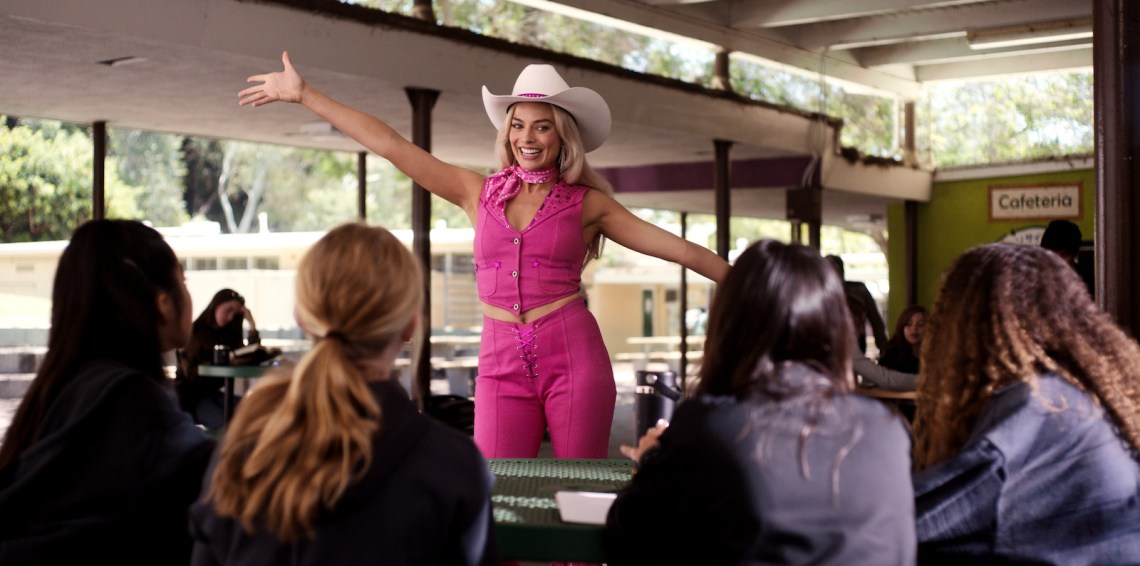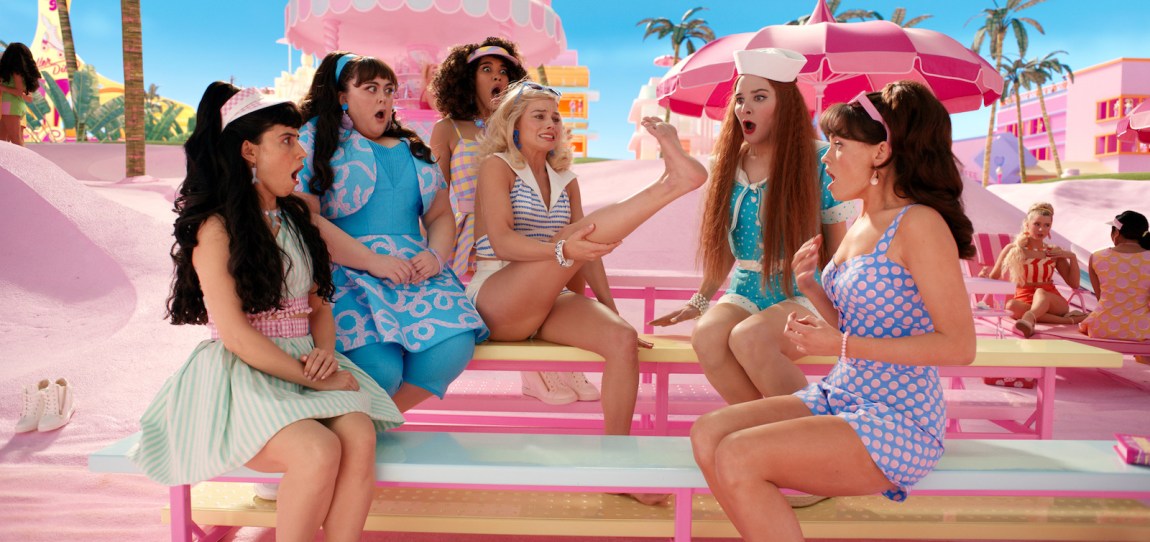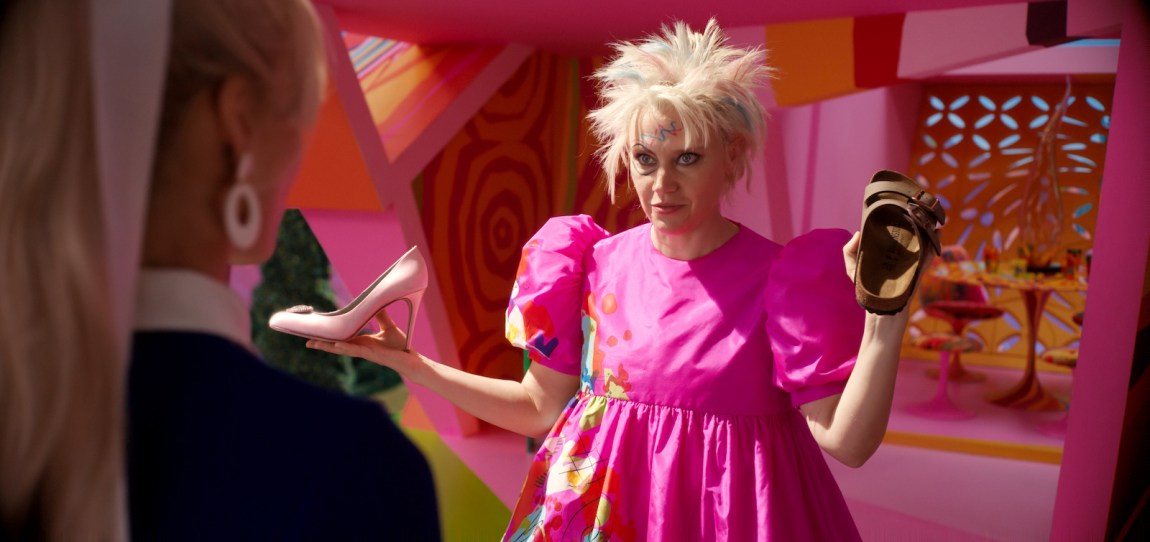Barbie has a lot in common with Valerie Cherish: two ramrod broads who never say die. That motto is a modus essendi, the stuff of which they are made. Cherish, played by Lisa Kudrow in the cringe comedy The Comeback, has an actual rod up her back, the corrective intervention from a childhood bout with scoliosis. Barbie is, quintessentially, plastic. Their surfaces, impressionable and impressionistic, keep us at arm’s length. Anne Anlin Cheng, in her book on the modernist exhibitions of Josephine Baker, writes that “objectification can be a kind of covering, too,” whose “surface quality…collapses the difference between person and representation.” Baker, who wore her own skin like a finely sewn garment, made such distinctions tricky—to enlivening effect.
As with Baker, it is not that Barbie and Cherish lack interiority or drives: Barbie is as industrious as any person or thing can be, and plenty of wants, or maybe one big one, press from beneath Kudrow’s aggressively lived-in performance of Cherish’s can-do spirit. Rather, depth is not on show here. Dollhood and comedic acting have much in common: they offer diligence and a smile. We are meant to marvel at their endurance.
The Comeback is recursive, showing a show within a show. A TV network is mounting an inane sitcom called Room and Bored starring four bright-eyed twentysomethings and Cherish, who, once upon a time in the early Nineties, enjoyed moderate fame as a comedic lead on a show called I’m It! before receding into obscurity. Her return—the comeback—arrives by way of network gimmickry. With Cherish in the role, or an actress of comparable irrelevance (and it must be an actress), Room and Bored can be packaged with a concurrently filmed reality show about an aging actress stepping back into the biz. Upon learning that casting in the former requires participation in the latter, Kim Fields, herself a sitcom actress playing a sitcom actress, remarks, “I mean, I’ll do another sitcom, but who is so desperate for a comeback that they want cameras to follow them around all day?”
The television we’re shown, then, is the work of acting in workaday television as the work of appearing on reality television. The Comeback pointedly effaces the line where one contractual indignity ends and the other begins. (“Reality TV is the reality of TV,” says Cherish, with a glance at the camera, as though to ensure it performs its job capturing her epiphanic wordplay.) We do not see Cherish except through the perspective of footage that may be broadcast. She is never not “on.”
But Cherish is game. She is game to fall and flail, to take her triumphs in miniature, and especially to be recognized as “being game,” as Lauren Berlant writes. This, for Berlant, makes her humorless. Humorlessness is commonly used to ascribe intractability—the refusal to go along, get along, the conspicuous scene made by someone who can’t take the joke. But that is only one, narrow definition: “what constitutes humorlessness is someone’s insistence that their version of a situation should rule the relational dynamic,” whether that insistence takes the form of “affectlessness, passive aggression, seriousness, bitter mirth, or any kind of warm emotion, even a smile.”
Humorless comedy, Berlant argues, invites witness to these refusals, to characters who insist upon their worldview and approach the world accordingly. Cherish is one of Berlant’s four exemplary humorless subjects, alongside Irving Rosenfeld, Christian Bale’s outerborough conman from American Hustle; the unnamed comedian in Colson Whitehead’s story “The Comedian”; and Rupert Pupkin in Martin Scorsese’s The King of Comedy (1982). They are distinct from one another in their forms of intransigence—gender, race, any consequential historical category affects who is seen as humorless and how so—but they are all the protagonists of comedic narratives that humor their attempts to assert control in settings where the state of things exceeds their grasp; they keep grasping nonetheless, as in Pupkin’s desperate shtick. They are exemplary, but that does not make them solitary. “We are all combover subjects,” Berlant writes, referring to the “rather elaborate” hairpiece that Rosenfeld, backed by the droning radio of declining infrastructure, carefully arranges in the mirror.
Cherish, Kudrow’s masterpiece, exhibits her “relational rigor mortis” with a mouth that must be elastic enough to preserve its shape. She combs with her face, Berlant writes, rather than her hair: “assembled and assemblaged in real time…not permitted to rest in frustration or defeat…like a body suspended midair, distressed and adjusting but to no relief.” Her means are as gendered as Rosenfeld’s coiffure. Her project is to be game without overplaying her significance, lest the peace of conventional social relations be disturbed—the hallmark of white femininity. (Black women have, in Namwali Serpell’s words, the “does not prefer to” bearing of “black nonchalance.”) Cherish, “like so many women, is fighting to be just a little extraordinary.” A comedienne.
Advertisement
*
That’s not Barbie, not yet. The first joke in Barbie, directed by Greta Gerwig and cowritten by Gerwig and Noah Baumbach, is effected by pastiche. It’s a good one. Against the barren wilderness of precivilization, little girls in Mary Janes and prairie dresses primitively play mother to their bald baby dolls. “Which can be fun, at least for a while, anyway,” says the narrator, adding wryly, as one little girl irons and another stirs a mixing bowl, “Ask your mother.” One day the girls are roused by the aura of a tall, slender figure. They are transfixed and, in the terms of the Kubrick homage, evolved. It’s Barbie, in the black-and-white one-piece and a perfect red lip. She’s it! Their monolith. Tea sets and porcelain heads are smashed. The voiceover confirms, “Yes, Barbie changed everything.”
There’s a knowing tone to that line. “Yes, Barbie changed everything. Then she changed it all again.” “Everything” is the teleology of girlhood, rendered by smiling Barbies in different outfits representing different vocations, tastefully spinning like spotlighted appliances out of a midcentury showroom. “Because Barbie can be anything, women can be anything,” the logic goes—anything including, but not limited to, tennis player, astronomer, pilot, veterinarian, hockey player, judge, astronaut, rhythmic gymnast, vocalist, chef, physician. She is white and tan and dark-skinned and disabled. The “everything” and “anything” of Barbie epitomizes the Mattel company line, but there is a gaping omission in this plainspoken mythology. Gerwig and Baumbach peer through that hole. Everything? Hm. As the narrator continues, “Thanks to Barbie all problems of feminism and equal rights have been solved.” Ha!
Here we’re introduced to Barbieland, a sovereign state with a quaintly indeterminate connection to our Real World. The comedy of Barbieland runs on dramatic irony, the unburst bubble. Barbie lives in her own house and drives her own car. The world is as bright and fun as fantasy can be, pink and plasticine and diverse. Barbie performs every role with beatific aplomb: waste management worker, construction worker, novelist, judge, litigator, president—all are she. It’s a utopia that can only just know itself as one, because it has never been otherwise. Mythology is all they have.
As Jane Hu notes in Dissent, Barbieland “lacks the historical consciousness that is born from political struggle,” a vulnerability that will become critical. (And yet, litigator Barbie emphasizes her dual capacity for “logic and feeling,” the seeming vestige of a prior grievance.) Among all the critics who have undertaken formal and informal essaying on Barbie, Hu is interested in how the film renders feminist ideation historically, starting with Barbieland, a feminine fantasy that comes with a wink. Everything in Barbieland, from attire to architecture, is conspicuously dated, “and so too are its fantasies,” she writes. Every day is Barbie’s “best day ever,” in Barbie’s own words, while Ken, the narrator explains, “only has a great day if Barbie looks at him.” The marginalized Kens seem content with this, absent one. Ressentiment in Barbieland belongs to the Ken played by Ryan Gosling, the only citizen not inclined to maintain a blissed-out expression. (But who cares, I say. Isn’t he “just” Ken?)
All would remain well in Barbieland in perpetuity, but things start happening to one Barbie in particular, played by Margot Robbie. During the nightly dance number, Barbie, without missing a beat, blurts out a question, “Do you guys ever think about dying?” The entire party, the whole world, it seems, stutters to a stop. Faces fall, but this Barbie’s smile remains in place, enabling a quick recovery. “I’m just dying to dance,” she improvises, and activity resumes. The next morning in the Barbie dream house, her pristine ritual, which we have previously seen go off without a hitch, hits several cricks: lethargy, eye boogers, bad breath, temperamental plumbing, burnt toast, sour milk.
But Barbie is not to be deterred from her routine. Barbie persists. When her arched feet go flat, she straps them into heeled Mary Janes anyway, wincing along her painful trek up the hill to consult “Weird Barbie,” described smilingly by another Barbie as “fated to an eternity of making other Barbies perfect while falling more and more into disrepair herself.” More droll than bizarre, Kate McKinnon’s Weird Barbie diagnoses Robbie’s Barbie—here identified as “Stereotypical Barbie”—with a case of onset “humanness,” evidence of interference between the Real World and theirs. Barbie must enter the Real World and discover and then resolve whatever is plaguing the little girl who is playing with her. (“We’re all being played with, babe,” Weird Barbie quips.) Unless she does so, she will continue “going funny.”
Advertisement
In I, Tonya—the biopic of the figure skater Tonya Harding, who became disgraced for her perceived involvement in an attack on Nancy Kerrigan—Robbie played the unequivocal outsider, vulgar and thick among priss misses. The camera effected a Frankenstein sensibility, suturing Harding’s feats and suffered abuses to Robbie’s pliant use of her features. This Harding does not “show up for her face,” as Cherish does in her relentless pursuit of minor recognition. It’s Harding’s face that must catch up, conform to the virtuosity of its host.
In a short, memorable scene in front of the mirror in a silent room somewhere in the bowels of a Lillehammer arena, site of a draining dream, Harding applies her blush in garish, stage quantities. She smiles over budding sobs—smiling not as method but as mask, as put-on as a plum-wine lip. Her tear, when it falls, represents something genuine leaking out from behind the showmanship. Nellie LaRoy, the ingenue played by Robbie in Babylon, about the unbounded dreamers of 1920s Hollywood, delivers an opposite tear to that same end. Her talent as an actress is proven, the film suggests, by her machinic command of her face. She is “off” until “on,” her eyes like faucets, and does the director want “one tear or two?” Both Harding and LaRoy are performers, locked in texts that, unlike Berlant’s humorless comedies, equate performance with imposture, a false front guarding true feeling.
Barbie is a different ask. Fish-out-of-water set pieces succeed by their protagonists’ humorlessness, their too-confident grasp on the unfamiliar scene they find themselves in. Their reality is their reality. Barbie and Ken glide into the Real World none the wiser about its conventions. For Ken, lacking an actualized identity apart from proximity to Barbie, this means safari: What else but to take everything in? For Barbie, actualization personified, the Real World is a set of confrontations. She holds her face in the face of many new-to-her encounters, such as catcalling and the hostile disaffection of emo tweens.
Among the latter is Sasha (Ariana Greenblatt), the “little girl” for whom Barbie has been searching. Barbie approaches, but she is intercepted by a sullen-faced classmate acting as a bouncer. Barbie is Barbie and won’t be deterred. “Don’t worry. Everyone really likes me and thinks I’m cool—and pretty,” she says, smiling. It is the same smile she gives the tweens, introducing herself with a laugh—a laugh grounding her shock at needing introduction at all—as “Barbie!” The smile wobbles but returns even after her dressing down by Sasha, who calls her a “fascist” among other enlightened critiques of the doll.
There are tears here, too, though Barbie doesn’t understand why she sheds them, lacking a frame of reference for the “sad, mushy” complications of sentimental feeling Weird Barbie warned about. “It’s happening again,” she remarks out loud; the corners of her mouth are working overtime. Barbie, who has “only ever wanted for everything to stay exactly as it is,” is resistant to change, even if change is an encounter with the way things have really been. It’s a combing over of humanness with dollness that, as Robbie does it, yields a most human performance.
*
Nothing is better than a broken-down doll, word to Tyra Banks. But Gerwig and Baumbach are after something else. High jinks return Barbie to Barbieland, which suits her just fine. She is accompanied by Sasha and her mother, Gloria (America Ferrera), and is all too eager to show how much her world hasn’t changed to this pair who inhabit a world much different than she thought. They are met by a nightmare. Ken has brought the good word of patriarchy back to Barbieland, soon renamed Kenland. Deprived of defenses, society capitulates. Patriarchy sweet-talks the Barbies out of their jobs and into domestic service, and the dream house is transformed into a man cave, foosball table and all. Barbie breaks down, casting off her accessories and flopping onto the astroturf to “wait and hope” for a solution to materialize from elsewhere. She is retrieved by Weird Barbie and roused by a speech from Gloria:
It is literally impossible to be a woman…. You have to be thin, but not too thin. And you can never say you want to be thin. You have to say you want to be healthy, but also you have to be thin. You have to have money, but you can’t ask for money because that’s crass. You have to be a boss, but you can’t be mean. You have to lead, but you can’t squash other people’s ideas. You’re supposed to love being a mother, but don’t talk about your kids all the damn time. You have to be a career woman, but also always be looking out for other people. You have to answer for men’s bad behavior, which is insane, but if you point that out, you’re accused of complaining. You’re supposed to stay pretty for men, but not so pretty that you tempt them too much or that you threaten other women because you’re supposed to be a part of the sisterhood. But always stand out and always be grateful. But never forget that the system is rigged. So find a way to acknowledge that but also always be grateful. You have to never get old, never be rude, never show off, never be selfish, never fall down, never fail, never show fear, never get out of line. It’s too hard! It’s too contradictory and nobody gives you a medal or says thank you!
I won’t litigate the sophistication of the speech. Gloria’s words not only stir once–Stereotypical Barbie into action, they snap other Barbies out of it, results replicable enough to take on the road. There is something demonstrative, Hu writes, in the fact that “the speech is almost immediately codified and repeated—turned from an inspiring monologue to a tired mantra,” a power in articulation that “could only work in an impossibly fictional world like Barbieland.” Yet the narrative time allotted to the speech, coupled with Ferrera’s energetic recitation, suggests revelation. Audiences are called upon to not only recognize their womanhood but also recognize it in a way that is recognizable by others, and that, to me, is not as interesting as anything else going on in the film.
The Barbies regain control, but Barbie is no fit for Barbieland’s beau idéal, having been too affected by the Real World. She has become, as Weird Barbie prophesized, “sad, mushy, and complicated,” the province of not just humans in general, the film suggests, but women in particular. She sheds her humorlessness for something even more recognizably feminine than the color pink, coaxing Ken into emotional autonomy and recognizing herself as the ideational daughter to a maternal figure, introduced at film’s end as Ruth Handler (Rhea Perlman), the woman who invented Barbie in 1959. Barbie becomes human, ready to take on the world in a tan blazer and rose Birkenstocks.
Barbie becomes its own humorless subject, recruiting the devices of melodrama in its assertion of what makes a human and betraying Gloria’s spirited dialectic. Barbie takes her maker’s hands and has an epiphany. It is a visceral—goosepimpling, pupil-contracting, eye-watering—experience. We’re shown a montage filled with girls and women and scenes of mothering, supplying an answer to its soundtrack, a Billie Eilish song called “What was I made for?” Womanhood and feeling become an entwined, embodied truth. (Eilish coos: “I don’t know how to feel/But I wanna try.”) It is time to drop the shtick, the film says, which is itself a kind of shtick. Plastic is moved offscreen, humanized.
The promise of plastic is at least as dated as the original Barbie, with good reason. (One popular glib—though by no means incorrect—critique of the toy, also hurled at Barbie in Barbie, addresses the amount of waste her feminine fantasy produces.) In a bygone era, plastic seemed poised to erode the distinction between people and things in the best way, liberating the body of its natural, limited form. But the “wonder” Roland Barthes documented in his essay “Plastic” (1957)—“plastic is the very idea of its infinite transformation”—now curdles to dread, and also distaste. Plastic is cheap and too much with us, says anyone with good judgment. “If materials like plastics, Bakelite, celluloid promised a new compatibility between the organic and the inorganic,” Cheng writes, “then by the mid-twentieth century, the larger generic category of plastics has degraded to associations with things cheap, insipid, and painfully artificial.” The aversion to a sheen of unabashed artifice has had a dulling effect on glamour, which she describes as an “essentially nostalgic category”:
It has faded from our lives, not because all the great movie stars and divas have vanished, but because the rich blankness of synthetic lives ushered in by early-century technological inventions and the crisis of personhood that these new inventions and materials in turn engendered have become less jarring, less urgent, less promising.
Barbie’s transformation means leaving self-proclaimed plastic behind. The film ends, in other words, by expressing a skepticism of the synthetic, which in the film is ultimately incompatible with realness. Real is tears and dimpled skin. Womanhood shall not be plastic or humorless, but as sentimental as ever. Barbie, we shall conclude, is a film about women, not dolls—flesh over faux. As though living does not require a measure of both. The final line of the film is a zinger, but the final shot is a smile.






